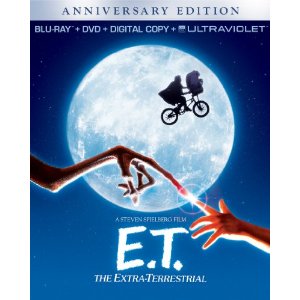The 60th anniversary of one of the best-loved movies of all time is being celebrated with gorgeous new DVD and Blu-Ray releases.
Silent movie star Don Lockwood (Gene Kelly) is paired on screen with Lina Lamont (Jean Hagan), who would like to be paired with him offscreen as well. But Lina’s personality is as grating as her squeaky, nasal voice. She is mean, selfish, arrogant, and stupid. Chased by fans following the opening of their latest movie, Don jumps into the car of Kathy Seldon (Debbie Reynolds), who tells him she is a serious actress, and not at all interested in the movies. But later, at a party celebrating the new movie, Kathy appears again, jumping out of a cake. Don teases her about her “art” and she throws a pie at him, getting Lina right in the face by mistake. Lina, furious, has Kathy fired.
At the party, the guests are treated to an exhibition of the latest technology, “talking pictures.” Everyone present dismisses it as a novelty. But when “The Jazz Singer” becomes a hit, everyone in Hollywood begins to make talkies. Production is halted on the latest Lockwood/Lamont movie, “The Dueling Cavalier,” while the stars are coached in vocal technique (with a delightful song mocking the exercises, “Moses Supposes”). But the movie is a disaster. Test audiences jeer and laugh.
Meanwhile, Don and Kathy have fallen in love. After an all-night session, Don, Kathy, and Don’s best friend, Cosmo (Donald O’Connor), come up with an idea. They can make it into a musical, “The Dancing Cavalier,” dubbing Kathy’s voice for Lina’s. Don resists at first, because it is unfair to Kathy. But they persuade him that it will just be this one time, and he goes along.
With Kathy’s voice and some musical numbers, the movie is a success. Lina insists that Kathy continue to dub all her movies, and, when the audience insists on hearing her sing, Lina forces Kathy to stand back stage so she can perform. But Don, Cosmo, and the beleagered studio head reveal the secret, and Don introduces Kathy to the audience as the real star of the movie.
Discussion: This is often considered the finest musical of all time. Certainly it has it all, classic musical numbers and a witty script, unusually sharp and satiric for a musical comedy, especially one making fun of the industry that produced it. Asked to name the top ten moments in the history of movies, most people would include the title number from this movie, in which Gene Kelly splashes and sings the rain with what Roger Ebert called “saturated ecstasy.” When he swings the umbrella around and around and dances on and off the curb, his “glorious feeling” is contagious. Only in a movie containing that sequence would Donald O’Connor’s sensational “Make ‘Em Laugh” number be mentioned second. It is a wildly funny pastiche of every possible slapstick gag, done with energy and skill so meticulous that it appears it is entirely spontaneous.
Screenwriters Betty Comden and Adoph Green, asked to use some of the classic songs by Arthur Freed (later producer of most of the great MGM musicals) and Nacio Herb Brown, decided to set the movie in the era in which they first appeared, the early talkies. This gave them a chance to use some of the Hollywood folklore of that era, when careers like John Gilbert’s were destroyed overnight, as audiences found out that their voices didn’t match their faces. One especially funny scene has the technicians trying to find a way to record Lina’s dialogue. When they put the microphone on her dress, all you hear is the sound of her pearls as she rubs them. When they put it lower down, you hear her heartbeat. When they put it near her, her voice fades in and out as she tosses her head. Note that the cameras are put inside huge boxes — that is authentic, as the cameras of that era were so loud that they had to be encased to prevent their own whirring from being recorded.
Don and Cosmo are consummate adaptors. As we see in flashback, they have already switched from vaudeville to movies, and then Cosmo from performer to accompanist (to musical director) and Don from stunt man to leading man. Lina resists change and tries to bully her way out of it, but Don, Cosmo, and Kathy all demonstrate resilience and openness to new ideas, and a willingness to be creative in solving problems.
Questions for Kids:
· Why does Kathy at first lie about liking the movies?
· Why does Don lie about his background? How is that different from the way that Lina behaves?
· Have there been any new inventions that you have seen that have changed people’s jobs a lot?
· What inventions do you use that your parents didn’t have when they were children? Your grandparents?
Connections: The transition from silent movies to talkies was also lampooned in the first play by George S. Kaufman and Moss Hart, “Once in a Lifetime.” A silent star who has become deranged is the centerpiece of “Sunset Boulevard.” When told “You used to be big in pictures,” she says, “I’m still big — it’s the pictures that got small.” She also says, memorably, that in her day stars didn’t need to talk: “We had faces then!”
Activities: Children might like to see some of the early silent movies to get an idea of what Hollywood was like in the days depicted in this movie. The films of Charlie Chaplin, Laurel and Hardy, Buster Keaton and Harold Lloyd are still wonderful, and kids will enjoy learning that a story can be told without words.

